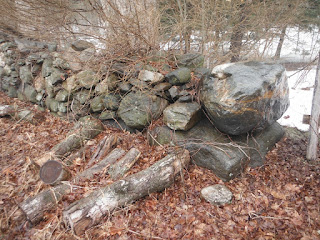“The Art of Looking - It can be taught, but
it’s hard for people to accept the fact that there’s a visual way of knowing,”
Stilgoe says.
The morning
catches me thinking about “Stone Fences” as opposed to “Stone Serpents,” and
how I disagree with many (if not most) researchers in the “borders around the
fields” department, here in the Watch House by the Nonnewaug Wigwams. I’m wondering how long it would take to
observe every single row of stones before one could confidently state that the
majority of these constructions appear to be either Indigenous made or are just
“farmers’ walls.”
I tickle Google to
see just what is meant by the term “farmers’ stone walls.”
I end up reading
a typical article about “stone walls*,” biased by the way Robert Thorson views
them (as linear landfills or garbage heaps), and I stopped a moment when I read this sentence: “Landscape historian John Stilgoe explains,
“The stone walls of New England … were built by men interested far more in
land-clearing than in fencing.”
That’s a name I know I’ve read somewhere, but
just to be sure I had to tickle Google yet again to find: “Stilgoe, a professor
of Visual and Environmental Studies since 1977, describes himself as “the kind
of person who wanders around noticing things.”
His title is the Robert and Lois Orchard Professor in the History of Landscape Development. Though his field is, ostensibly, how the American landscape has changed since the 1500s, he’s published on everything from shipwrecks to the joy of bicycling. What he teaches is not so much “a specific topic, but an approach,” as current student Sam H. Rashba ’14-’15 describes it.
Stilgoe wants
his students to notice—to be able to process and interpret visual information
by opening themselves up to the subject. What it comes down to is looking.
“It can be taught,
but it’s hard for people to accept the fact that there’s a visual way of
knowing,” Stilgoe says. As debates about the value of the humanities rage on,
Stilgoe has no doubt that what he teaches is relevant, even urgent…”By 1985, it
was very clear to me that fewer and fewer students were coming into college
having had any kind of formal education in just going for a walk,” Stilgoe
says. “And then, of course, came all of the digital devices. I’m stunned by how
much time you all spend looking at screens. It’s time you’re not looking at
something else.”
(Such as the actual “stone walls,” I’m thinking, as I read
further:)
“Stilgoe
attributes this decline in visual acuity in part to increased emphasis on
standardized testing; he wonders why there’s no visual component on the SAT…
“What I do is
probably going to fade out of the universities because there’s so much money to
be made doing what I do in the private sector,” Stilgoe says. “A load of men
and some women go into what I do essentially for police work.”
… as Stilgoe
continually reminds his students, there’s a lot of power in looking.
“When you start to teach people to [notice things], you
destroy the larger narrative,” Stilgoe says.
Well, yes, professor
Stilgoe, I just might agree with that – adding only how difficult that
sometimes seems to be, surrounded by Indigenous Stonework few people are even
curious enough to look at in person.
https://www.thecrimson.com/article/2015/4/2/scrutiny-john-stilgoe/
“Then Again: Vermont’s stone walls were
never meant as fences” by Mark Bushnell (Jan 27 2019):
“Thorson
was surprised by the stone walls he saw when he moved to the East. Having grown
up on North Dakota and worked in Alaska, he was used to wide-open spaces. In
New England, he encountered much smaller spaces, and wall after wall. “What
struck me was how massive they were,” he says, not individually, but
collectively. So he set off to discover how this came to be. Thorson made himself
an expert on the walls – examining how and why they were built – and came to
appreciate them in a way that he learned their creators did not.
The
walls are as part of nature as anthills, Thorson says. “The ant doesn’t build
these beautiful hills on purpose. The ant doesn’t even care about the hills,”
he says. “We fixate on the ant hill, because we see it. The ant doesn’t. To it,
they are just disposal piles.”
That is
exactly what stone walls were. In the days before stonewall building became an
art form, the walls were “linear landfills,” in Thorson’s phrase. As landscape
historian John Stilgoe explains, “The stone walls of New England … were built
by men interested far more in land-clearing than in fencing.”
https://vtdigger.org/2019/01/27/vermonts-stone-walls-never-meant-fences/








Thank you for sharing this. If only more people would walk through the woods to find stone walls and wonder about them like a child. People may learn to inspect stone walls closely for the signatures of the Indigenous stone masons and the iconography they built into their stone works.
ReplyDelete